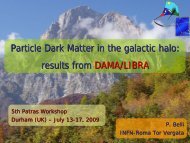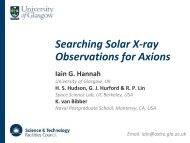John Hartnett Mike Tobar Rhys Povey Joerg Jaeckel
Search for hidden sector photons in a microwave cavity experiment
Search for hidden sector photons in a microwave cavity experiment
You also want an ePaper? Increase the reach of your titles
YUMPU automatically turns print PDFs into web optimized ePapers that Google loves.
<strong>John</strong> <strong>Hartnett</strong>, <strong>Mike</strong> <strong>Tobar</strong>, <strong>Rhys</strong><br />
<strong>Povey</strong>, <strong>Joerg</strong> <strong>Jaeckel</strong><br />
DURHAM UNIVERSITY<br />
The 5th Patras Workshop on Axions, WIMPs and WISPs
Frequency Standards and Metrology<br />
Precision Microwave Oscillators and Interferometers: From Testing<br />
Fundamental Physics to Commercial and Space Applications<br />
Michael E. <strong>Tobar</strong><br />
ARC Australian Laureate Fellow<br />
School of Physics<br />
University of Western Australia, Perth<br />
Frequency Standards and Metrology Research Group
High-Precision Oscillators,<br />
Clocks and Interferometers<br />
Generating and measuring frequency, time<br />
and phase at the highest precision<br />
Applied<br />
Technolgy<br />
Telecommunications<br />
Radar<br />
Navigation<br />
Surveying<br />
Space<br />
Physics Experiments<br />
Test of General Relativity<br />
Search for drift in Fine<br />
Structure Constant<br />
Search for the Axion<br />
Detect quantum fluctuations<br />
in macroscopic objects<br />
Detect GW’s
Research<br />
Testing fundamental physics<br />
1. Lorentz Invariance<br />
2. Rotating cryogenic oscillator experiment<br />
3. Odd parity magnetic MZ Interferometer experiment<br />
4. Generation and detection of the Paraphoton<br />
Commercial Applications<br />
1. Microwave Interferometer as a noise detector<br />
2. Sapphire Oscillators (room temperature and cryogenic)<br />
Atomic Clock Ensemble in Space (ACES) Mission<br />
1. Australian User Group<br />
2. Long term operation of high precision clocks<br />
Astronomy<br />
1. Cryogenic Sapphire Oscillators better than H-masers<br />
2. With MIT, image black hole at the centre of the Galaxy<br />
3. Within Australia -> SKA and VLBI timing
• Whispering Gallery modes WGE(H) mnp<br />
• Vertically stacked<br />
• TM 0np (n = 0,1; p = 0,1,2,3)<br />
• Vertically stacked<br />
• TE 0np (n = 0,1; p = 0,1,2,3)<br />
• Vertically stacked
WGE 16,0,0
HEMEX Whispering<br />
Gallery Mode<br />
Sapphire resonator<br />
WGH 16,0,0<br />
at 11.200 GHz
Cavity mounted inside inner can
Stability
80<br />
8<br />
secondary<br />
coupling<br />
probe<br />
sapphire<br />
51.00<br />
30 50<br />
11.83<br />
19<br />
silver plated<br />
copper<br />
cavity<br />
copper<br />
clamp<br />
copper nut<br />
primary<br />
coupling<br />
probe<br />
10
TE mode: E θ field
TE 011<br />
TM 010
Cavity resonance<br />
frequency<br />
Paraphoton wavenumber
Resonance Q-factor<br />
coupling<br />
Paraphoton<br />
mass<br />
|G|~ 1
Probability of Detection<br />
Assuming<br />
P em = 1 W, P det = 10 -24 W, Q ~ 10 9 ,<br />
χ ~ 3.2 × 10 -11
For 6 pairs of<br />
Niobium cylinders<br />
(stacked axially) with<br />
2 GHz < ω 0 /2π < 20<br />
GHz and ω 0 ≥ k ≥ 0<br />
Microwave<br />
cavities<br />
Q~10 11 , ….6 orders of magnitude better than Coulomb<br />
experiment
QuickTime and a<br />
decompressor<br />
are needed to see this picture.<br />
QuickTime and a<br />
decompressor<br />
are needed to see this picture.<br />
k 0<br />
=ω 0<br />
/c (resonance) k γ<br />
= paraphoton k γ2<br />
=ω 2 – m<br />
2<br />
γ
QuickTime and a<br />
decompressor<br />
are needed to see this picture.<br />
QuickTime and a<br />
decompressor<br />
are needed to see this picture.
QuickTime and a<br />
decompressor<br />
are needed to see this picture.<br />
QuickTime and a<br />
decompressor<br />
are needed to see this picture.
QuickTime and a<br />
decompressor<br />
are needed to see this picture.<br />
QuickTime and a<br />
decompressor<br />
are needed to see this picture.
QuickTime and a<br />
decompressor<br />
are needed to see this picture.<br />
QuickTime and a<br />
decompressor<br />
are needed to see this picture.<br />
QuickTime and a<br />
decompressor<br />
are needed to see this picture.
QuickTime and a<br />
decompressor<br />
are needed to see this picture.<br />
QuickTime and a<br />
decompressor<br />
are needed to see this picture.<br />
QuickTime and a<br />
decompressor<br />
are needed to see this picture.<br />
QuickTime and a<br />
decompressor<br />
are needed to see this picture.
QuickTime and a<br />
decompressor<br />
are needed to see this picture.
• Q =Rs/G<br />
G=Geometric factor & Rs = surface resistance<br />
3500<br />
3000<br />
2500<br />
G [Ohms]<br />
2000<br />
1500<br />
10 GHz<br />
mode<br />
1000<br />
T ≤ 4 K Niobium Q~ 10 9<br />
500<br />
0.5 1 1.5 2 2.5 3 3.5<br />
Freq [Hz]<br />
x 10 10
• In sapphire very high Q ~ 10 9 without Niobium<br />
• ? G for high m seems small, need to confirm, as<br />
numeric integral needs to be checked
• Assuming<br />
• detection bandwidth Δf = 1 Hz<br />
• receiver temperature T = 1 K (very good amp)<br />
thermal noise power kTΔf = -199 dBm<br />
Power@ 1paraphoton per second S/N = 1<br />
freq hf/s dBm Seconds<br />
10 GHz 6.63E-24 -202 2<br />
1 GHz 6.63E-25 -212 21
• Isolation will be the biggest problem<br />
• Microwave leakage<br />
• Unity coupling probes to cavities<br />
• No reflected power<br />
• Tuning High Q resonances exactly to the same<br />
frequency




